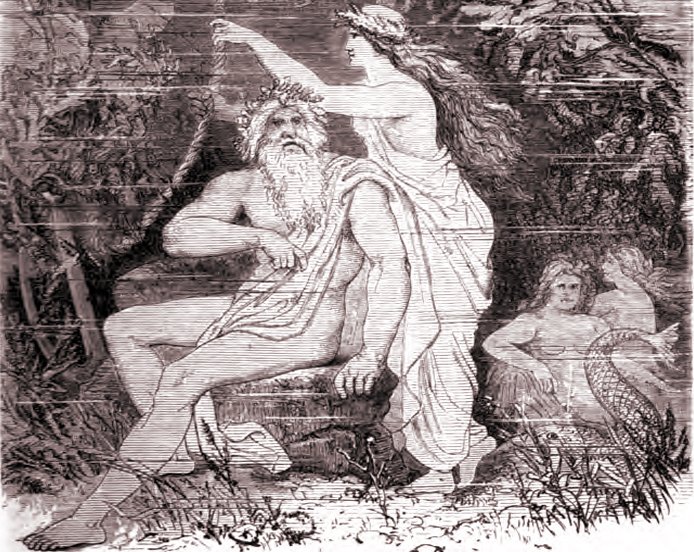Aegir – Jotun Lord Of The Stormy Seas Revered And Feared By Norsemen
A. Sutherland - AncientPages.com - In Norse mythology, Aegir (Ægir) was the ancient jotun lord of the sea, who belonged to a primeval order of gods, predating the Aesir, the Vanir, two different races of Norse gods.
“Aegir and Ran.” Aegir sits and rests his arm on a stone, while his wife Ran pulls on a rope connected to an anchor. Mermaids lounge in the background. Friedrich Wilhelm Heine (1845-1921) after an original by Friedrich Wilhelm Engelhard (1813-1902). Source
Fathered by the great giant Ymir, Aegir was considered omnipotent within his realm. He was the one who existed before them, and he would survive long after they died.
Aegir was usually portrayed as an older man with long white hair and clawlike hands. He lived in a great hall in coral caves beneath the island of Hlesey, (probably the island of Laeso ("Isle of Hlér" "Island of Hlér,") which is the largest island in the North Sea bay of Kattegat, Denmark.
He was a personification of the ocean, often compared to the 'greedy destroyer' in the poetry of seamen and sailors.
In legends of the Anglo-Saxon people, the sea god Aegir was known as 'Eagor.' He was known as Hler ('the shelterer') among the Northern nations and Gymir ('the concealer'). He was a good friend of the Aesir gods, and according to legend, Aegir and Ran organized exquisite underwater banquets for drowned men and gods in the depths of the sea.
However, it was not always so.
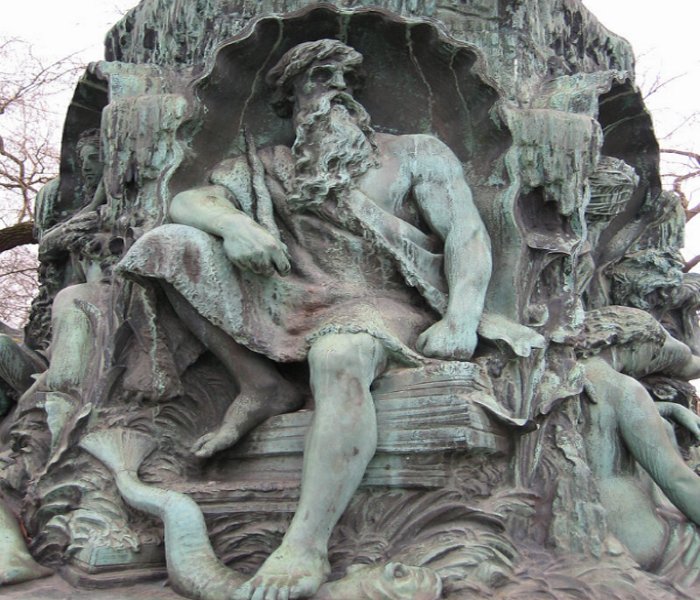 Fountain of JP Molin at Kungsträdgården in Stockholm, 1866. Image credit: Hedning - CC BY-SA 3.0
Fountain of JP Molin at Kungsträdgården in Stockholm, 1866. Image credit: Hedning - CC BY-SA 3.0
"At first, he was no friend of the Aesir. Thor, however, intimidating him with piercing eyes, constrained him to give a banquet for the gods each winter in his own hall; later, he, in turn, paid visits to the Aesir, who received him in a friendly manner. His banquets were in very truth merrymakings, at which ale flowed of its own accord; his hall was lighted by gleaming gold instead of candles; his brisk serving men, Eldir and Fimafeng, ministered to the guests…" 1
In his 'Skáldskaparmál' (or 'language of poetry'), the second part of the Younger Edda, Snorri Sturluson says that Aegir lived with his sister-wife, Ran. The couple had two servants, Eldir and Fimafeng, and nine beautiful giantess daughters (the Wave Maidens) who wore veils and white robes.
The nine daughters of Aegir were his foster mothers. Number nine was of great importance for ancient cultures and their beliefs. It was Odin who mated with them simultaneously to produce Heimdallr, who guarded Asgard and illuminated the world.
There were nine muses, and Hydra, the mythological monster, had nine heads. During the Han Dynasty, cosmology was based on the number nine for a time prevalent Sheol - "nine sources" - The Abode of the Dead. It was believed that Nine Unknown Men were guardians of forbidden knowledge hidden from humanity. In Chinese beliefs, Phoenix was the nine-headed bird ("Jiu Feng"), a monster in Chinese mythology.
There was a time when the Vikings, the masters of the sea, believed in Njord, Aegir, and his wife, Ran. Njord was responsible for the sea near the shore, the wind off the sea, fishing, and trade. His duty was also to calm down dangerous storms created far out at sea by Aegir.
Aegir was revered and feared by sailors experiencing furious storms on the sea. They believed that Aegir – usually angry and hostile - would occasionally appear suddenly to take ships, boats, men, and cargo with him to his underwater domain at the bottom of the ocean. His sisted-wife Ran was even more dangerous.
In Norse mythology, she was known for her presence behind the ice masses, always prepared to act. Using a net, she would capture sailors from their ships and drag them beneath the ocean's waves. There, she reigned alongside her husband, Aegir.
Ran was considered the goddess associated with death for those lost at sea. According to one legend, sailors who perished might reappear at their funeral feasts. Ran was especially inclined to offer them hospitality in her halls if they carried gold overboard. She had a fondness for gold.
Even if they were not her favorites, she wasn't unfriendly. As at Odin's Valhalla, the mead was served at will in the halls of the goddess Ran.
Aegir was a divine ruler of the sea. Ancient people associated with the sea depended on him and his terrible mood. Their faith in Aegir was based on fear; the crews of merchant and fishing boats usually had to navigate far from the shore and home.
They needed a safe journey across the sea; nobody had to remind them that they should always plead to Aegir.
Written by - A. Sutherland - AncientPages.com Senior Staff Writer
Updated on July 6, 2024
Copyright © AncientPages.com All rights reserved. This material may not be published, broadcast, rewritten or redistributed in whole or part without the express written permission of AncientPages.com
Expand for referencesReferences:
H. R. Ellis Davidson in 'Gods and Myths of Northern Europe'
Guerber H. A. Myths of the Norsemen: From the Eddas and Sagas
More From Ancient Pages
-
 Baffling Structures Unearthed In A Place Where Prehistoric Human Remains Are Missing Is An Ancient Mystery
Ancient Mysteries | Apr 19, 2021
Baffling Structures Unearthed In A Place Where Prehistoric Human Remains Are Missing Is An Ancient Mystery
Ancient Mysteries | Apr 19, 2021 -
 Khufu Boat And Unique Boat-Building Technique Of Ancient Egyptians
Artifacts | Jun 20, 2017
Khufu Boat And Unique Boat-Building Technique Of Ancient Egyptians
Artifacts | Jun 20, 2017 -
 On This Day In History: Declaration Of Arbroath – The Scots Reaffirm Their Independence – On Apr 6, 1320
News | Apr 6, 2016
On This Day In History: Declaration Of Arbroath – The Scots Reaffirm Their Independence – On Apr 6, 1320
News | Apr 6, 2016 -
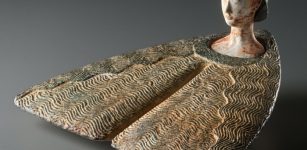 Strange Flat Idol Sculpture From Bactria Remains Unexplained
Artifacts | Sep 26, 2019
Strange Flat Idol Sculpture From Bactria Remains Unexplained
Artifacts | Sep 26, 2019 -
 Complex Of Goguryeo Tombs: Beautiful Ancient Wall Paintings Displaying History And Mythology Of North Korea
Civilizations | Oct 19, 2018
Complex Of Goguryeo Tombs: Beautiful Ancient Wall Paintings Displaying History And Mythology Of North Korea
Civilizations | Oct 19, 2018 -
 Easter Island May Offer Proof Of An Alien Apocalypse
Archaeology | Jun 7, 2018
Easter Island May Offer Proof Of An Alien Apocalypse
Archaeology | Jun 7, 2018 -
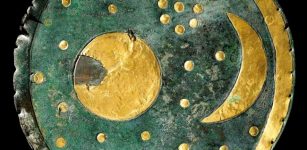 Nebra Disc – Artifact That Represents 3,600-Year-Old Astronomical Knowledge
Artifacts | May 26, 2014
Nebra Disc – Artifact That Represents 3,600-Year-Old Astronomical Knowledge
Artifacts | May 26, 2014 -
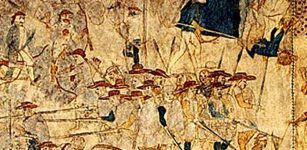 On This Day In History: Spanish Villasur Expedition Wiped Out By Pawnee And Otoe Warriors – On August 14, 1720
News | Aug 14, 2016
On This Day In History: Spanish Villasur Expedition Wiped Out By Pawnee And Otoe Warriors – On August 14, 1720
News | Aug 14, 2016 -
 Baffling Unexplained ‘Alien’ Condition – Evidence Of Unknown DNA?
Featured Stories | Jan 6, 2021
Baffling Unexplained ‘Alien’ Condition – Evidence Of Unknown DNA?
Featured Stories | Jan 6, 2021 -
 New Archaeological Discoveries In The Temple Of Khnum At Esna, Luxor
Archaeology | Dec 29, 2022
New Archaeological Discoveries In The Temple Of Khnum At Esna, Luxor
Archaeology | Dec 29, 2022 -
 Unique 1,300-Year-Old Pala Period Idol Of Snake Goddess, Nag Devi Discovered Near Nalanda University, India
Archaeology | Apr 5, 2022
Unique 1,300-Year-Old Pala Period Idol Of Snake Goddess, Nag Devi Discovered Near Nalanda University, India
Archaeology | Apr 5, 2022 -
 Ancient Roman Sandal With Nails And Game Pieces Found Under A Playground In Germany
Archaeology | Nov 22, 2024
Ancient Roman Sandal With Nails And Game Pieces Found Under A Playground In Germany
Archaeology | Nov 22, 2024 -
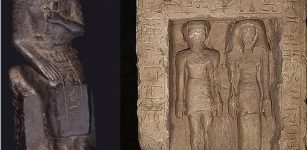 Excavation At Tell Edfu Reveals Early New Kingdom Complex
Archaeology | Jan 10, 2019
Excavation At Tell Edfu Reveals Early New Kingdom Complex
Archaeology | Jan 10, 2019 -
 Celtiberians: Intriguing Martial Culture And Their Skilled Warrior Infantry
Civilizations | Jul 13, 2024
Celtiberians: Intriguing Martial Culture And Their Skilled Warrior Infantry
Civilizations | Jul 13, 2024 -
 On This Day In History: Berlin Opened For One Day – On Dec 20, 1963
News | Dec 20, 2016
On This Day In History: Berlin Opened For One Day – On Dec 20, 1963
News | Dec 20, 2016 -
 Australia’s First Marine Aboriginal Archaeological Site Questioned
Archaeology | Jun 22, 2022
Australia’s First Marine Aboriginal Archaeological Site Questioned
Archaeology | Jun 22, 2022 -
 Face Of Man From The Lost Medieval Village Of Dzwonowo Reconstructed Using 3D Printing Technology
Archaeology | Jul 20, 2020
Face Of Man From The Lost Medieval Village Of Dzwonowo Reconstructed Using 3D Printing Technology
Archaeology | Jul 20, 2020 -
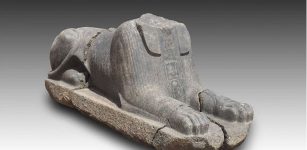 Mini Sphinxes, Huge Baboon Statue And Blocks From Khufu’s Reign Discovered In Heliopolis
Archaeology | Jun 20, 2022
Mini Sphinxes, Huge Baboon Statue And Blocks From Khufu’s Reign Discovered In Heliopolis
Archaeology | Jun 20, 2022 -
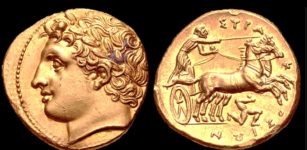 Agathocles Of Syracuse: Sicilian Ruler Who Committed Numerous Crimes Saved And Extended Sovereignty Of Sicily
Featured Stories | Jul 26, 2019
Agathocles Of Syracuse: Sicilian Ruler Who Committed Numerous Crimes Saved And Extended Sovereignty Of Sicily
Featured Stories | Jul 26, 2019 -
 2,000-Year-Old Skull Reveals Ancient Romans May Have Been The First To Breed Flat-Faced Dogs
Archaeology | Jun 15, 2023
2,000-Year-Old Skull Reveals Ancient Romans May Have Been The First To Breed Flat-Faced Dogs
Archaeology | Jun 15, 2023

